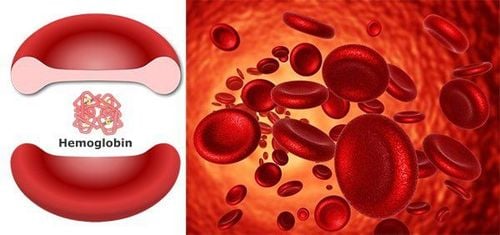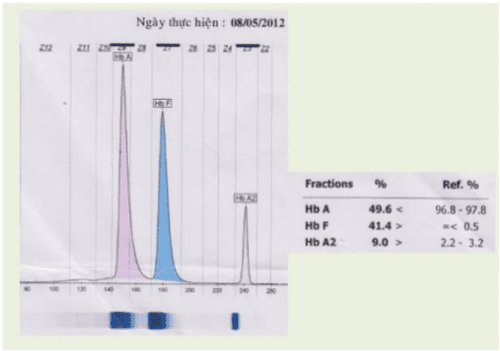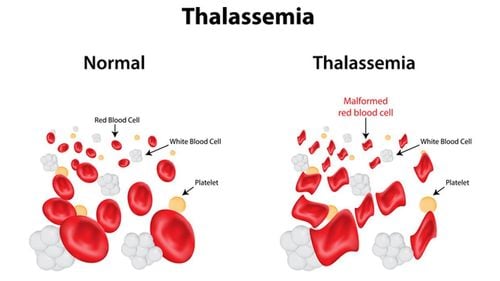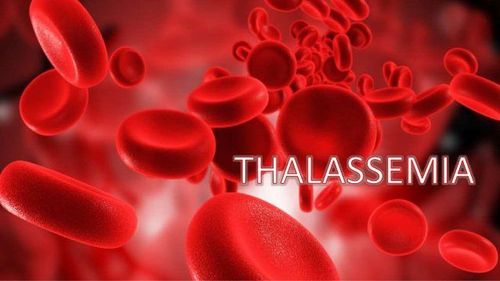This is an automatically translated article.
The article is professionally consulted by Master, Doctor Pham Thi Thuy Nhung - Head of Laboratory Department - Vinmec Hai Phong International General HospitalHemoglobin is a protein in red blood cells responsible for transporting oxygen from the lungs to the rest of the body. There are different types of hemoglobin in red blood cells. Hemoglobin electrophoresis, a test that measures these types of hemoglobin in the blood and looks for abnormal hemoglobin types, has a role in the screening and diagnosis of hemolytic disease.
1. What is hemoglobin electrophoresis?
Hemoglobin electrophoresis is a blood test done to check different types of hemoglobin in the blood. Hemoglobin or hemoglobin is a component in red blood cells that carries oxygen to the organs in the body.
The most common types of normal hemoglobin are:
Hemoglobin A: This is the most common type of hemoglobin commonly found in adults. In severe cases of thalassemia, hemoglobin A levels are low and hemoglobin F levels high. Hemoglobin F (fetal hemoglobin): This type is commonly found in fetuses and newborns. Hemoglobin F is replaced by hemoglobin A (mature hemoglobin) shortly after birth. Only a very small amount of hemoglobin F is made after birth. Some diseases, such as sickle cell disease, aplastic anemia, and leukemia, will have abnormal types of hemoglobin present in the blood and a higher amount of hemoglobin F. Hemoglobin A2: This is a normal type of hemoglobin found in small amounts in adults. Besides the normal types of hemoglobin, there are more than 350 types of abnormal hemoglobin, namely:
Hemoglobin S: This type of hemoglobin is present in sickle cell disease. Hemoglobin C: This type of hemoglobin is not able to carry oxygen well Hemoglobin E: This type of hemoglobin is found in people of Southeast Asian descent. Hemoglobin D: This type of hemoglobin is found in some sickle cell disorders.

Of these, hemoglobin S and hemoglobin C are the most common types of abnormal hemoglobin that can be found by hemoglobin electrophoresis.
The basic principle of hemoglobin electrophoresis is to use electric current to separate and quantify normal and abnormal hemoglobin in the blood. Different types of hemoglobin have different electrical charges and move at different speeds, appearing on different electrophoresis paper.
When the normal type of hemoglobin has an abnormal concentration or an abnormal type of hemoglobin is present in the blood, it can mean that the body has a disease. However, certain types of abnormal hemoglobin can also be present in a person's blood without any other symptoms or can range from mild symptoms to life-threatening illnesses. network. For example, hemoglobin S is found in sickle cell disease, which is a serious abnormality that causes red blood cell malformations and is prone to embolism. Low hemoglobin A levels are noted in hemolytic anemia.
2. When should hemoglobin electrophoresis be performed?
Hemoglobin electrophoresis is performed to:
Determine the presence and quantification of each type of hemoglobin in the blood. This can be used to diagnose certain types of anemia, such as thalassemia. Check the results of treatment for diseases with an abnormal type of hemoglobin in the blood. Screening for hemolytic anemia acts as a prenatal test to help couples find out the possibility of having a child with hemolytic anemia passed down from parent to child.

3. How is hemoglobin electrophoresis performed?
The nurse or laboratory technician will take a blood sample from a vein in the patient's arm using a syringe. After the needle is inserted, a small amount of blood will be collected into a test tube. Specimens are preserved in a specialized environment and quickly brought to the laboratory for processing according to the correct procedures before running hemoglobin electrophoresis.
To check hemoglobin electrophoresis in an infant, blood will be drawn by cleaning the baby's heel with alcohol and poking the heel with a fine needle. A few drops of blood will be collected and the wound will be quickly bandaged.
4. The results of hemoglobin electrophoresis
Hemoglobin electrophoresis is a blood test done to check the presence and concentration of different types of hemoglobin in the blood. Results will be available in a few days.
4.1 Normal hemoglobin results Normal values are listed by hemoglobin type during hemoglobin electrophoresis as follows:
Hemoglobin A1: 96.5%–98.5% of total hemoglobin Hemoglobin A2: 1, 5%–3.5% of total hemoglobin Hemoglobin F: 0%-1% of total hemoglobin However, this normal range is a reference value, which may vary between laboratories but is not significant. tell.

4.2 Abnormal hemoglobin results When HbA is normal, HbF is normal, and HbA2 is elevated, it indicates thalassemia minor. When the specimen shows higher than normal amounts of both hemoglobin A2 and hemoglobin F, the diagnosis is made of thalassemia intermedia. If hemoglobin A is very low and hemoglobin HbA2, HbF is high, the person may have a more serious form of thalassemia.
Besides, when there are abnormal types of hemoglobin, it will be in different conditions:
Hemoglobin S in high amounts is directed towards sickle cell disease.
Hemoglobin C in large quantities is directed towards hemoglobin C disease, clinically manifesting as anemia and splenomegaly.
Hemoglobin E in high amounts is pointed towards hemoglobin E disease, which also causes anemia and smaller-than-normal red blood cells.
In addition, hemoglobin electrophoresis test also detects more than 350 types of abnormal hemoglobin but the rate is very rare.
5. Factors that can affect hemoglobin electrophoresis results
Hemoglobin electrophoresis in screening for hemophilia can be influenced by the following factors:
Have had a blood transfusion in the last 3 months Concomitant iron deficiency anemia. This may interfere with the results of hemoglobin A2 Therefore, when the patient is suspected of having a family factor and the clinical and subclinical manifestations are directed towards, a screening test for congenital hemolytic disease is indicated. Hemoglobin electrophoresis needs to choose the appropriate time to perform, avoiding factors that can lead to false negatives and miss the diagnosis.
In summary, hemoglobin electrophoresis is used as a screening test to evaluate and identify variant and abnormal hemoglobin and diagnose hemoglobin disorders including hemolysis. For populations with high prevalence or familial factors, it is important to perform screening for hemolytic anemia with hemoglobin electrophoresis. At Vinmec International General Hospital, hemoglobin electrophoresis test is performed in the examination and treatment of diseases and pre-marital health check-up packages and prenatal diagnosis with suspected cases of pregnant women and fetuses. have genetic abnormalities or hemophilia. Accordingly, the hemoglobin electrophoresis test at Vinmec is carried out methodically and in accordance with standard procedures by a team of highly qualified medical professionals and modern machinery, thus giving accurate results, contributing to plays an important role in determining disease and disease stage. From there, there is an effective way to consult and treat patients.
Please dial HOTLINE for more information or register for an appointment HERE. Download MyVinmec app to make appointments faster and to manage your bookings easily.














